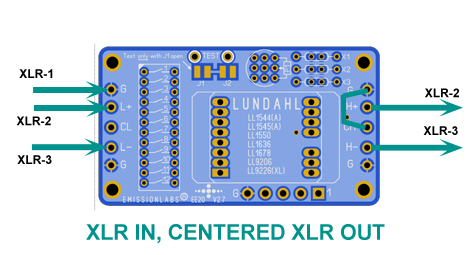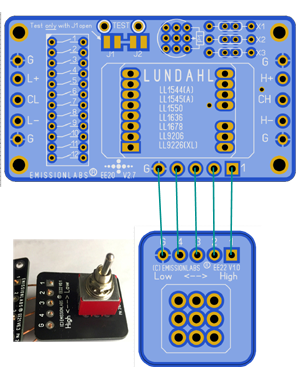Electron Engine ™
Printed Circuit Boards by Emissionlabs
EE20 Multi Purpose Board.
For LL1636, LL1678, LL9206, LL9226, LL9226XL
 Moving Coil, Applications. (You are now here)
Moving Coil, Applications. (You are now here) - Moving Coil, Tuning
- Audio Board, Applications
- Audio Board, Tuning
Using EE20 stand alone
With the EE20 board, there is no need to use the data sheet, finding out connections. Just choose from the table below here, the required gain factor. Set the Piano Switch as in column 'Option1'. Connect input and output as in one of the Circuits, and already the board is working.
Using EE22 with EE20 together
EE22 is an additional PCB, which can be attached to a working EE20. With EE22 you have the possibility to change between two gain factors. Which two factors that will be, is set by the piano switch. Settings for using EE22 are under 'Option2'
What you receive is a small PCB and a high quality switch (with silver internal contacts). EE22 is mounted on the chassis with the switch itself. So very easy to construct.
The order number for the EE22 + switch is: 310-022-29
Detailed explanation
The MC cartridge is connected to L+ and L-. Adjustable damping of the MC cartridge is possible as well.
 All Lundahl options, and some additional step up ratios have become possible, which are not in the data sheet. All of which can be tried out conveniently, just by setting the the switch itself.
All Lundahl options, and some additional step up ratios have become possible, which are not in the data sheet. All of which can be tried out conveniently, just by setting the the switch itself.
Gain |
Set Switches |
||||
#1 |
Designation |
USE of EE20 without external switch board. | USE of EE20 with external switch board EE22. |
||
OPTION1 |
OPTION2 |
||||
#2 |
4x |
2.5x |
New! Possible with EE20 board |
1, 3, 7, 9, 11 | 7, 9, 11, Low (High = twice the gain) |
#3 |
5.3x |
3.3x |
New! Possible with EE20 board
|
1, 3, 5, 7, 8, 11 | 5, 7, 8, 11, Low (High = twice the gain) |
#4 |
8x |
5x |
Lundahl Alt A |
2, 7, 9, 11 | 7, 9, 11, High (Low = half the gain) |
#5 |
8x |
5x |
Lundahl Alt B |
1, 3, 5, 7, 8, 10, 12 | 5, 7, 8, 10, 12, Low (High = twice the gain) |
#6 |
11x |
6.7x |
New! Possible with EE20 board
|
2, 5, 7, 8, 11 | 5, 7, 8, 11, High (Low = half the gain) |
#7 |
16x |
10x |
Lundahl Alt C Most recommended |
2, 5, 7, 8, 10, 12 | 5, 7, 8, 10, 12, High (Low = half the gain) |
#8 |
16x |
10x |
Lundahl Alt D Only for very low impedance cartridges. |
1, 3, 4, 5, 6, 8, 10, 12 |
4, 5, 6, 8, 10, 12, Low (High = twice the gain) |
#9 |
32x |
20x |
Lundahl Alt E |
2, 4, 5, 6, 8, 10, 12 | 4, 5, 6, 8, 10, 12, High (Low = half the gain) |
About the transformers used:
Per Lundahl told me this by phone: Anything you change to a transformer, you do this to achieve something. A change however, will always cause other data to change as well. All produced transformers have a well balanced set of specifications. But it does explain, why some have the same transfer ratio, but have other electrical data still.
LL9226 is an improved version of LL9206. There is LL9226 and LL9226-XL.
LL9226-XL is wound with thicker wire, which increases efficiency. This reduces noise at the loudspeaker, compared with the same loudness. The thicker wire makes the windings package larger, which requires a larger core. Since this cobalt core is expensive, this reflects in the price. An additional advantage is lower distortion of the larger core. The trade off is a slightly smaller frequency range, but as we are out in the 90kHz range, this should play no audible role.
LL1678 is the gain master, maximum 32x is really very much and there is no alternative for the good price, and high frequency range.
LL1636 can also be used. It compares to LL9206, but it has an internal shield, which very much reduces the hum sensitivity, and it should be used for environments where hum is a problem. The price for this, is the space, this shield takes internally in the transformer. So the wire diameter has to be thinner. This slightly reduces the efficiency, which reduction is very little though. This makes Ll1636 the ultimate MC transformer for a hum sensitive environment. LL1636 can also be used as a microphone transformer, but this is a totally different application, not addressed by EE20.
Some possible Connection Schemes
Circuit #1
Most recommended for Record Players.
Works with all transformers, also LL1636.
This connection scheme is the most used. Basically everything is grounded to the PCB Ground plane, which is double sided.
This uses a normal, grounded RCA connector, all wiring is classical and normal, and little to say about it, with no complications or difficulties. 
Circuit #2. For floating ground RCA input.
Works only with LL1636
a floating input is something very difficult for a step up transformer, because it works only with a transformer with static shield between the primary and secondary. Such a transformer is LL1636. This MAY become a problem solver for hums problems for which the reason can not really be found. The only difference between with circuit #1 or #2 is:
- Circuit #2 does not use the small ground link from L- to G (as in circuit#1)
- A floating ground RCA connector must be used.
- Circuit #1 can be used with all transformers, also LL1636
- Circuit #2 works only with LL1636.


Yamamoto Floating Ground RCA (Cinch) Connector
Usage:
- Create a Moving Coil RCA input with a MM amplifier, while the board EE20 is build inside the amplifier. This requires floating ground connectors.
- Not recommended, but you can try with standard (grounded) connectors, if these are already mounted and you have no option to change something. In that case, make a link from L- to G, and only the RCA center pin is connected to L+. Yet if it is humming, you need to install a floating ground RCA chassis connector. (like the picture above).
- Create a separate box, with RCA input and RCA Output. With a metal case, connect it to where it says Ground on the schematic. The input is a floating type connector, the output is a grounded type.
Circuit #3. For XLR input and XLR output.
XLR input works only with LL1636
XLR output works with all transformers

This is for an external box. XLR is not floating, but is centered to ground, by connecting it's center (CH connection) to ground. XLR-1 (cable ground shield) should NOT be connected to anything. (That would cause a ground loop, when XLR-1 is grounded inside the RIAA amplifier).
At the input: It has to be tried out, what is best for the Input XLR-1 ground connection, because this connects the record player chassis to the RIAA amplifier chassis. Try this out, and take what is best. When it makes no difference, connect Input XLR-1 to 'G'. To be universal, use a miniature external switch for this.
Circuit #3. For XLR input and floating XLR output.
XLR input works only with LL1636
XLR output works with all transformers

This is for an external box. Since the output is floating, the board ground should be connected to the record player chassis, via XLR-1. Be sure, this ciruit is what you want, because the RIAA must deal with a high level of common mode signal. The ground link in the "Centered XLR Output" (Circuit #2) prevents this.
 Attaching the small EE22 board.
Attaching the small EE22 board.
- It works with all of the above circuits.
- EE22 is optional, and allows to change between two adjescent gain factors of your choice.
- Piano switch settings for this are in the table above here.